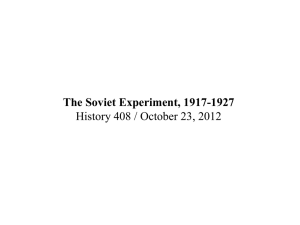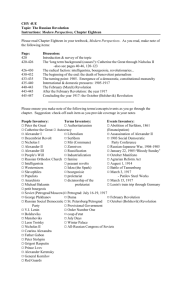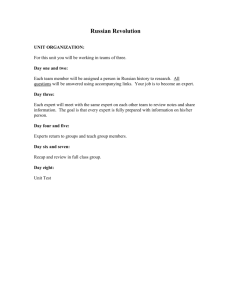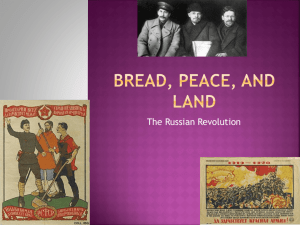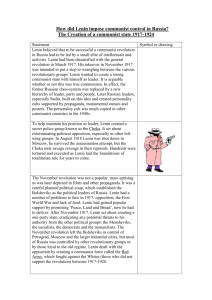Lenin's Russia - Timeline Key Personalities: Vladimir Ilyich Lenin
advertisement
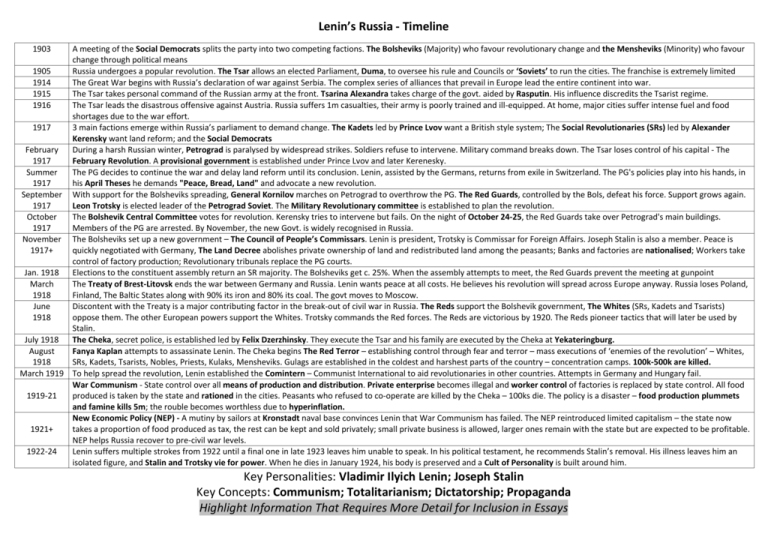
Lenin’s Russia - Timeline 1903 A meeting of the Social Democrats splits the party into two competing factions. The Bolsheviks (Majority) who favour revolutionary change and the Mensheviks (Minority) who favour change through political means 1905 Russia undergoes a popular revolution. The Tsar allows an elected Parliament, Duma, to oversee his rule and Councils or ‘Soviets’ to run the cities. The franchise is extremely limited 1914 The Great War begins with Russia’s declaration of war against Serbia. The complex series of alliances that prevail in Europe lead the entire continent into war. 1915 The Tsar takes personal command of the Russian army at the front. Tsarina Alexandra takes charge of the govt. aided by Rasputin. His influence discredits the Tsarist regime. 1916 The Tsar leads the disastrous offensive against Austria. Russia suffers 1m casualties, their army is poorly trained and ill-equipped. At home, major cities suffer intense fuel and food shortages due to the war effort. 1917 3 main factions emerge within Russia’s parliament to demand change. The Kadets led by Prince Lvov want a British style system; The Social Revolutionaries (SRs) led by Alexander Kerensky want land reform; and the Social Democrats February During a harsh Russian winter, Petrograd is paralysed by widespread strikes. Soldiers refuse to intervene. Military command breaks down. The Tsar loses control of his capital - The 1917 February Revolution. A provisional government is established under Prince Lvov and later Kerenesky. Summer The PG decides to continue the war and delay land reform until its conclusion. Lenin, assisted by the Germans, returns from exile in Switzerland. The PG's policies play into his hands, in 1917 his April Theses he demands "Peace, Bread, Land" and advocate a new revolution. September With support for the Bolsheviks spreading, General Kornilov marches on Petrograd to overthrow the PG. The Red Guards, controlled by the Bols, defeat his force. Support grows again. 1917 Leon Trotsky is elected leader of the Petrograd Soviet. The Military Revolutionary committee is established to plan the revolution. October The Bolshevik Central Committee votes for revolution. Kerensky tries to intervene but fails. On the night of October 24-25, the Red Guards take over Petrograd's main buildings. 1917 Members of the PG are arrested. By November, the new Govt. is widely recognised in Russia. November The Bolsheviks set up a new government – The Council of People’s Commissars. Lenin is president, Trotsky is Commissar for Foreign Affairs. Joseph Stalin is also a member. Peace is 1917+ quickly negotiated with Germany, The Land Decree abolishes private ownership of land and redistributed land among the peasants; Banks and factories are nationalised; Workers take control of factory production; Revolutionary tribunals replace the PG courts. Jan. 1918 Elections to the constituent assembly return an SR majority. The Bolsheviks get c. 25%. When the assembly attempts to meet, the Red Guards prevent the meeting at gunpoint March The Treaty of Brest-Litovsk ends the war between Germany and Russia. Lenin wants peace at all costs. He believes his revolution will spread across Europe anyway. Russia loses Poland, 1918 Finland, The Baltic States along with 90% its iron and 80% its coal. The govt moves to Moscow. June Discontent with the Treaty is a major contributing factor in the break-out of civil war in Russia. The Reds support the Bolshevik government, The Whites (SRs, Kadets and Tsarists) 1918 oppose them. The other European powers support the Whites. Trotsky commands the Red forces. The Reds are victorious by 1920. The Reds pioneer tactics that will later be used by Stalin. July 1918 The Cheka, secret police, is established led by Felix Dzerzhinsky. They execute the Tsar and his family are executed by the Cheka at Yekateringburg. August Fanya Kaplan attempts to assassinate Lenin. The Cheka begins The Red Terror – establishing control through fear and terror – mass executions of ‘enemies of the revolution’ – Whites, 1918 SRs, Kadets, Tsarists, Nobles, Priests, Kulaks, Mensheviks. Gulags are established in the coldest and harshest parts of the country – concentration camps. 100k-500k are killed. March 1919 To help spread the revolution, Lenin established the Comintern – Communist International to aid revolutionaries in other countries. Attempts in Germany and Hungary fail. War Communism - State control over all means of production and distribution. Private enterprise becomes illegal and worker control of factories is replaced by state control. All food 1919-21 produced is taken by the state and rationed in the cities. Peasants who refused to co-operate are killed by the Cheka – 100ks die. The policy is a disaster – food production plummets and famine kills 5m; the rouble becomes worthless due to hyperinflation. New Economic Policy (NEP) - A mutiny by sailors at Kronstadt naval base convinces Lenin that War Communism has failed. The NEP reintroduced limited capitalism – the state now 1921+ takes a proportion of food produced as tax, the rest can be kept and sold privately; small private business is allowed, larger ones remain with the state but are expected to be profitable. NEP helps Russia recover to pre-civil war levels. 1922-24 Lenin suffers multiple strokes from 1922 until a final one in late 1923 leaves him unable to speak. In his political testament, he recommends Stalin’s removal. His illness leaves him an isolated figure, and Stalin and Trotsky vie for power. When he dies in January 1924, his body is preserved and a Cult of Personality is built around him. Key Personalities: Vladimir Ilyich Lenin; Joseph Stalin Key Concepts: Communism; Totalitarianism; Dictatorship; Propaganda Highlight Information That Requires More Detail for Inclusion in Essays




